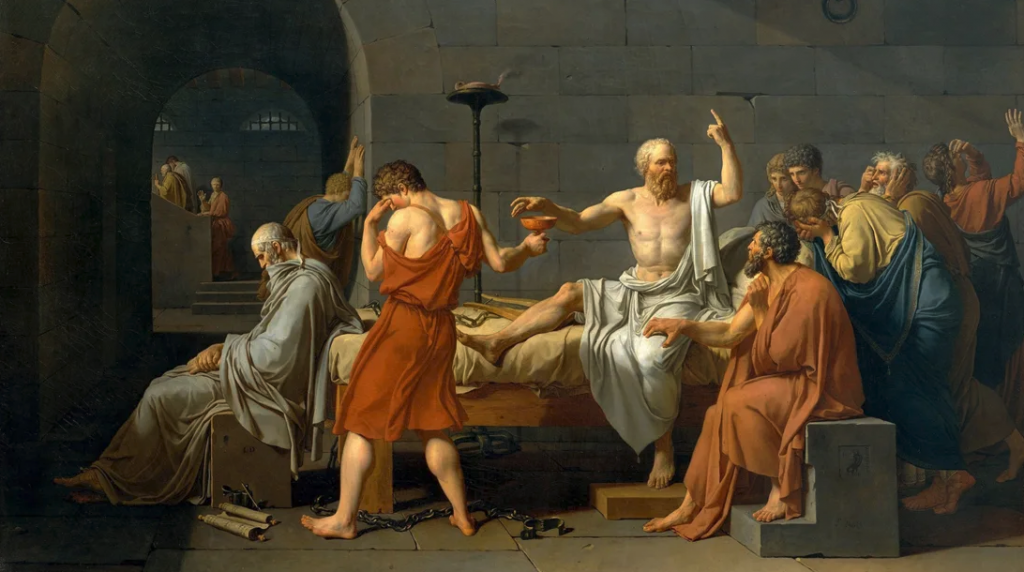
Jacques Louis David’s The Death of Socrates belongs to a genre of paintings of the Greek philosophers that seek to represent not only the philosopher but also something about their philosophies. The 17th century Dutch painter Hendrick ter Brugghen, for example, portrayed the philosopher Democritus of Abdera laughing. This is meant to capture the fact that Democritus’ ethical fragments seem to convey an optimistic outlook (for which in antiquity Democritus already earned the appellation ‘the laughing philosopher’).
But there’s an important difference between David’s painting and ter Brugghen’s. Democritus might have had a sunny disposition (we don’t know), but this is not what makes him an important philosopher (almost everyone agrees that what was most important about Democritus’ work was his theory of nature, which anticipated modern atomic theory by about 2000 years – a hard thing to represent in a painting!). By contrast, David’s painting does convey something central to the importance of Socrates as a philosopher. The painting portrays the final moments of Socrates’ life, in which Socrates calmly accepts a chalice of hemlock (a poisonous herb) after being sentenced to death, a moment depicted by Plato in the final pages of the Phaedo.
The fact that Socrates died in this way is not merely a biographical detail, but is in fact central to understanding who he was and why he was an important philosopher. Nearly all the Greek philosophers viewed philosophy not merely as an intellectual pass-time or a purely theoretical enterprise, but rather as something which can and should serve as the basis upon which we live our lives. In this connection Socrates was widely considered to be a role model: already in antiquity Socrates was remembered primarily not because of any of his philosophical views or arguments, but because of his philosophical life, including, importantly, how his philosophical commitments informed how he faced death.
Socrates was sentenced to death because of his practice of engaging in philosophical conversation about ethical, religious, and political matters. Although Socrates never claims to have the answers to the questions he investigates, he does succeed in showing that his interlocutors don’t have the answers either, despite their initial claims to the contrary. By undermining the authority of many powerful people in this way, Socrates engendered a lot of enemies and this ultimately led to him being tried on bogus charges of ‘not believing in the gods of the city and corrupting the youth.’ According to Plato’s account, the events that followed were highly unusual. Instead of apologizing for his actions and promising to change his behavior, as many people would have done, Socrates explains in his defense that under no circumstances will he stop engaging in philosophical inquiry. This isn’t just stubbornness: Socrates gives philosophical reasons for thinking that the practice of philosophical enquiry is necessary for life well lived and his commitment to his philosophical view is such that he would rather accept death than live otherwise.
Next, after receiving a guilty verdict, Socrates is given the opportunity to suggest a punishment. Normally one would be expected to suggest a fine or exile in order to avoid the death penalty, but again Socrates surprises. He gives a philosophical argument: since he has done nothing wrong, he would be complicit in injustice if he suggested an unjust punishment (the ‘punishment’ that Socrates defiantly suggests he deserves is free room and board for life, a reward given to Olympic victors). Then, after the sentence of death is delivered, Socrates’ friends offer to bribe the guards of the jail to allow Socrates to escape, but Socrates again refuses, arguing on philosophical grounds that this too would be unjust. Finally, when the moment arrives for the poison to be consumed, while his friends are distraught, Socrates gives philosophical arguments for thinking that death is nothing to be feared, and, in Plato’s portrayal, remains jovial and cheerful until the end.
This is the image of Socrates that David deftly conveys: while his friends are weeping and dejected, Socrates sits upright accepting the chalice without hesitation, showing no sign of distress (except, perhaps, a hint of irritation at the reaction of those around him). It is a striking image, in no small part because the strength that Socrates displays is both rare and, to many of us, desirable. Since Socrates’ courage and integrity was tied up with his philosophical practice and views, he acquired semi-legendary status among philosophers in antiquity. Multiple philosophical schools claimed to be heirs of Socrates, including the Stoics, who often remarked that Socrates may have been the only truly wise person who has ever lived. In later antiquity, the story of how Socrates faced death gave rise to a genre of (mostly apocryphal) stories about how different philosophers died, the idea being that one can judge different philosophies by how well they prepare their practitioners for death. Few professional philosophers think this way nowadays, but it’s not hard to admire the ideal that Socrates, and David’s portrayal of him, represents.
